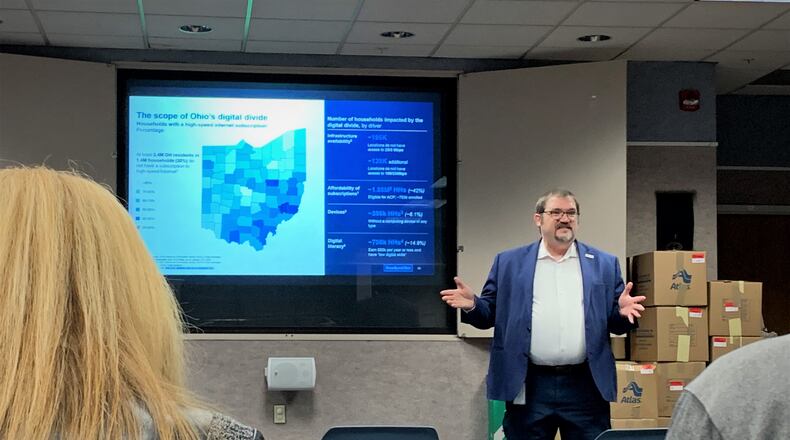National attention has been placed on broadband in recent years, as both the COVID-19 pandemic and the increased digitization of healthcare, business, education and other sectors has left communities without high-speed internet lacking.
Being able to better connect people with those services over the internet would be “excellent,” said Raphael Allen, Director of Community Outreach for the Springfield Foundation.
“It would hit so many different aspects, whether it be access to online telehealth, research for schools,” he said. “When COVID first came to rise, students that were in the college setting, they didn’t have Internet access to their home, so they had to come to the college.”
For example, Allen said he suspects Clark County’s southwest corridor, as well as Springfield’s downtown area, would benefit from broadband expansion.
“It may not have a direct tie to food insecurities, or homelessness, or whatever the case is. But it’s just one more benefit that we can add to strengthen our communities,” he added.
Broadband internet has a minimum 25 megabits per second download speed, and 3 Mbps upload speed, and is faster and more reliable than dial-up internet. As part of Broadband Ohio’s program, Internet Service Providers will be required to provide minimum 100 megabits per second download speed, and 20 megabits upload speed.
“That’s fast enough to be on a Zoom call,” said Peter Voderberg, Chief of Broadband Ohio. “It’s fast enough to have a couple of devices connected at the same time, so your kids can be on with a teacher, while you’re on with your coworkers.”
The federal government has a two-pronged approach to closing the so-called “digital divide.” The Broadband Equity, Access, and Deployment (BEAD) Program has set aside $42.5 billion nationwide to put broadband cables in the ground and Wi-Fi signals in the air. The Digital Equity Act has $2.75 billion to provide people with hardware, digital tools, and education on how to use those tools safely and effectively.
The state has also invested in workforce programs to train people to install and maintain Ohio’s broadband networks.
“We want (people) to be a part of the modern economy,” said Voderberg. “To be able to talk to your doctor through telehealth, to talk to your colleagues. Certain organizations are putting all of their trainings online.”
Data from the Federal Communications Commission indicates there are 195,000 Ohio addresses who are “unserved,” meaning they couldn’t get broadband internet even if they wanted to. Another 139,000 are “underserved,” meaning they can potentially get the minimum level broadband internet, but it’s spotty, unreliable, or not up to the 100 Mb upload standard. Upward of 4 million Ohio addresses are served by high-speed broadband.
Many people with insufficient internet live in rural areas where running fiber doesn’t make sense to private companies.
Gary Kirkpatrick, of Spring Valley Twp., said he has gone through everything from dial-up, ISDN, HughesNet, to AT&T and T-Mobile, and said sometimes how much data the company says you’ll get in the area, isn’t how much speed you actually get.
“AT&T got their new equipment, and said ‘You get eight megabits per second!’ ” Kirkpatrick said, adding he asked a lineman for the company to test his connection.
“You can’t get more than six. He said, ‘Matter of fact, I’m pretty amazed you get six,’ " Kirkpatrick said of the lineman.
Other people that don’t have broadband are urban and even suburban, in some cases living just down the street from people that do. However, whether it’s because of installation costs or low projected profits, internet service providers won’t install broadband in those places unless residents fork over tens of thousands of dollars to fund it themselves.
“We’ve heard a lot of this coming from people,” said Kelly Louis with Connectivity Champions in Cincinnati. “They’ll (build) down your street but if you’re half mile off the road, they won’t run it to your house unless you drop ten grand out of pocket.”
The federal government has dedicated billions to make sure rural and low-income communities — and other places internet service providers wouldn’t otherwise go because they don’t generate a return on investment — are able to access, and afford, that technology.
Connectivity Champions is also helping people sign up for the Affordable Connectivity Program, where qualifying families can get $30 off their internet bill, typically through their service provider.
“The problem with federal programs is that nobody knows about them,” said Darrell Mitchell, of Connectivity Champions. “That’s what our goal is, to let people know what’s happening and how do you get signed up.”
Broadband provides high-speed internet access via multiple technologies, including fiber optics, wireless, cable, and others. The state of Ohio is “technology-neutral” Voderberg said, meaning as long as companies can prove they meet minimum standard speeds and levels of reliability, fiber cables will not be favored over wireless, for example, where the latter might make sense.
Other local governments have their own broadband initiatives in the works. The Greene County Commission last year dedicated nearly $10 million of its American Rescue Plan Act funds to building out high-speed broadband, primarily in the eastern part of the county. Montgomery County’s Digital Advisory Committee also held its own community talks in Brookville and East and West Dayton this week about internet connectivity and affordability.
“We must have the infrastructure in place to support reliable internet access, but expanding fiber networks into rural areas like Brookville and Jefferson Township isn’t enough,” said Montgomery County Administrator Michael Colbert. “People also need access to devices, and service must be affordable so they can remain connected.”
About the Author

